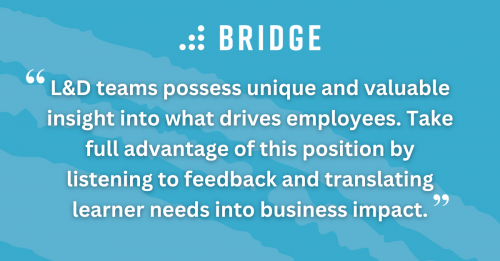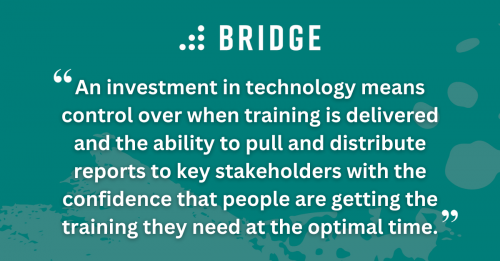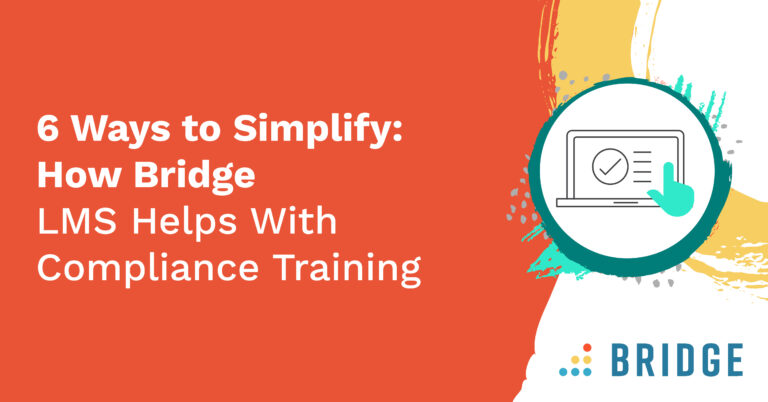The value of learning and development (L&D) programs on organizational performance, culture, and employee experience can’t be overstated. Training and employee development should be positioned as an investment rather than a cost. With buy-in from stakeholders, training programs have the potential to enrich and empower your talent and drive productivity, innovation, and deliver great results.
Though a Gartner survey shows that the biggest challenge for 54% of CFOs in 2023 is hiring and retaining talent, they’re also working to keep prices down and cut unnecessary costs.
To protect your budget, make it go further, and deliver optimal value, you need a strategic approach that reinforces the impact of learning and development on performance.
Step 1: Talk With Stakeholders
Amid economic uncertainty, with competing priorities and tight spending, defending your L&D budget takes a focused, clearly-communicated approach with transparent and measurable goals that benefit the entire organization.
This requires collaboration, communication, and clarity at all levels.
Understand Your CFO’s Priorities
As outlined in a McKinsey article, CFOs have increasingly diverse responsibilities, with roles expanding to support building capabilities within the organization. Although four in ten CFOs report driving the most value through performance management and strategic leadership, less than half have had time to focus on skills and talent development. While that means they’re increasingly responsible for talent decisions, don’t always expect them to speak the same language.
Know how to speak your CFO’s language and understand their priorities. Your metrics show how training and development initiatives contribute to organizational performance, so tie these to data around cost, budget allocation, and return on investment.
Do Your Research
Do your research and be prepared to justify each request, because the cost associated with not investing in learning and development could be enormous. Developing a budget with greater awareness of the context can reinforce L&D as a necessity, not a “nice to have”.
In a competitive environment, your people see workplace learning as a differentiator that sets employers apart and makes the difference in hiring, retaining, and addressing talent shortages. When you invest in your people, everyone wins. According to McKinsey, organizations that closely align business processes and play an active role in developing skills experience a:
- 50% increase in employee engagement
- 50% reduction in training and development program costs
- 40% increase in productivity
L&D plays a role in attracting and retaining talent too. Gallup’s 2022 State of the Global Workplace report backs this up, as organizations that offer people opportunities to learn and grow report 43% lower staff turnover.
Similarly, keep a close eye on what’s happening elsewhere within your industry to see the budget others allocate to L&D initiatives, the areas where they’re increasing headcount, and the learning technologies and solutions they’re using. An in-depth view of current and upcoming needs allows you to benchmark training budget requests against other industries and organizations.
TIPS TO COMMUNICATE THE VALUE OF L&D | ‘How to Get Your CEO to Increase L&D Budgets’
Conduct a Talent Review
Collaboration is crucial in balancing needs and requests. Connect with leaders, managers, and department heads across the company to uncover priorities, such as where they currently have skills gaps or where they anticipate training in the future.
While research shows that the average cost-per-hire is over $4,600 (that expense soars to over $28,000 for new executive hires), reskilling your existing employees saves time and money.
Conduct a talent review with your HR partners to estimate the cost of hiring against the cost of reskilling your workforce and put together a training plan. Present cost savings for new headcount as part of your budget conversations.

UNCOVER ACTIONABLE WAYS TO ALIGN GOALS WITH OUTPUT | ‘How to Measure Employee Productivity‘
Step 2: Showcase the Value of Your L&D Strategy
Oracle and PwC research shows that nearly half of business leaders see the inability to measure value as a barrier to success. Communicate the value of your L&D costs with an in-depth investigation of the competitive advantage training gives your organization:
Analyze What L&D Initiatives Drive Organizational Performance
Track business goals and targets, showing the effectiveness of existing strategies. A careful examination of training initiatives and their measurable outcomes on performance goals such as profit, growth, and acquisition will clearly show the areas where L&D adds the most value.
You’ll want to show how existing strategies successfully contribute toward organizational goals to justify costs or replicate success. A learning management system that links learning, skills, and performance data will present the figures and the impact of training and development.
Even compliance training has a value, and fines for companies skipping out on mandatory training can be costly. For example, financial non-compliance alone resulted in fines totalling $6.4 billion in 2022, according to The Securities and Exchange Commission.
SHOW LEADERS WHY YOUR LEARNING PROGRAMS AREN’T OPTIONAL | ‘Making the Case for Your Learning Platform in a Time of Economic Uncertainty’
Highlight Learner Engagement and Satisfaction Rates
Though the return on investment from employee experience measures may not always be clear-cut, Gartner predicts that people-centric metrics such as wellbeing, burnout, and satisfaction will override traditional ROI figures when making investment decisions. The need to consider these metrics is clear—according to Gallup, employee turnover costs organizations $1 trillion every year.
L&D teams possess unique and valuable insight into what drives employees. Take full advantage of this position by listening to feedback and translating learner needs into business impact.
Analyze learner data and request feedback about the learning methods and formats that resonate with your people and how engaging and valuable they find course content. Evidence from employee engagement surveys, course feedback, and one-on-one feedback can all test the temperature of people’s satisfaction and reinforce the benefits of learning and development effectiveness.
MORE WAYS TO MAKE THE CASE FOR YOUR L&D BUDGET | ‘Cost of Employee Training and Development’
Review Skills Gaps
Keep your organization one step ahead by focusing on the most in-demand skills and behaviors today and for the future, and then closing those gaps. To achieve this, look at how your people use skills in practice.
Regular skills assessments and 360 feedback from peers and managers reveal what talent exists, how people use skills, and whether they can effectively deploy these skills and behaviors by mobilizing talent. When you align this data with high-priority objectives, you’ll see how employees use, retain, and share knowledge. The figures from a Deloitte report back this up— organizations that take a skills-based development approach are 63% more likely to achieve results and 49% more likely to maximize efficiency.

EXPLORE MORE PRACTICAL WAYS TO EMBED A SKILLS-BASED APPROACH | ‘How Personalized Learning Enhances Employee Skills Development
Step 3: How to Make Your Learning and Development Budget Go Further
To make strategic decisions about your L&D spending, use current data, future priorities, and organizational goals and find ways to achieve more with what you have.
Demonstrate that you’ve covered all bases with a proposal of data-driven results and practical next steps that reduce costs and increase profit.
Look at What Processes Can Be Automated
When you automate your scheduling and content delivery, you make training more efficient. Implementing intelligent scheduling and learning pathways to deliver content at the moment of need can prevent unnecessary repetition of information, cutting down course training times.
Aside from time spent learning, scheduling course tracking, analytics, and reminders frees up valuable time spent on admin. An investment in technology means control over when training is delivered, the ability to control the flow of information, and the ability to pull and distribute reports to key stakeholders with the confidence that people are getting the training they need at the optimal time.
Calculate the Value Your LMS Adds
Dive into the data and calculate the time and money your learning management system (LMS) saves. If your team previously conducted in-person training, factor in venue and instructors savings through online learning, a reduction in materials, and time spent traveling.
Gather evidence to show where skills training has made a measurable difference to the business as a result of training. An increase in sign-ups, engagement, or a reduction in course completion time all illustrate the value when linked to performance outcomes. Showing what skills and behaviors learners have developed and how they drive revenue can also justify the need for L&D.
SEE HOW BRIDGE JOURNEYS CAN AUTOMATE MANDATORY TRAINING | ‘5 Ways to Strengthen Your Training Programs’
Encourage Informal Self-Directed and Peer Learning
Self-directed learning is a valuable way for your employees to absorb information at a pace and in a way that meets their needs, meaning they get the most from your learning programs.
Consider what knowledge already exists within your talent and how to distribute and share it. Informal learning opportunities like coaching, resource-sharing, and mentoring that use relevant, engaging, and easily accessible content make your budget go further and fit seamlessly into the daily flow of work. Not only is this an effective use of resources, it also boosts your learning culture.
ENGAGE REMOTE TEAMS IN TRAINING | ‘4 Ways to Boost Your Learning and Development Strategy for the Hybrid Workplace’
Streamline Your Learning Offering
Curate existing content to decide what’s essential and what’s “nice to have”, then look at where time and resources are currently being spent creating and updating content. Consider what skills and behaviors are essential and what courses already exist.
Look for ways to streamline content, remove duplicated or outdated material, and deliver material in engaging formats. With access to an on-demand learning library, employees can learn wherever and whenever they prefer—cutting out the planning and costs associated with in-person and instructor-led training. For partners and customers outside your organization, easy access to relevant and high-quality content is a priority to develop in-depth knowledge and build relationships.

FUEL ORGANIZATION GROWTH WITH LEARNING | ‘How Learning and Performance Can Connect, Align, and Grow Your Organization’
Step 4: Write an Executive Summary
Be sure to include the following in your executive summary, and use this as a blueprint to have the conversation.
Start With the Challenge/Pain Points and Present the Solution
Recognize the challenges and make it clear you have the solution. After all, the responsibility of L&D teams is to bring clarity and prepare for the uncertain future through strategy and planning.
Show that you’ve thoroughly researched your strategy, acknowledge the challenges, and then clearly present the evidence.
Use the following examples for inspiration:
- “Given the need to save money, I’ve reviewed our learning and development strategy and identified three ways to streamline processes.”
- “I’m keen to maximize the value of our learning and development budget, so I’ve analyzed the data and found some additional ways we can drive revenue.”
- “I’ve looked for ways to save money and make our training budget more efficient. After reviewing the figures, I have some suggestions about how investing in technology can increase productivity and performance.”
- “Training and employee development is one of the best investments we can make.”
Show How Your Learning and Development Strategy Addresses Challenges
You want your CFO to move in step with your department, and that means easy access to the systems and data which mean something to them. With better communication and transparency, it’s a matter of sharing your plans and what you need from them.
Once you’ve acknowledged the challenges, show them what your team has previously accomplished, what you plan to do, and how you’ll do it.
Use the following examples for inspiration:
- “We’ll automate course enrollment, delivery, and reporting to give learners the skills at the optimal time. Creating learning pathways will increase employee performance and information retention.”
- “By looking to existing employees to share knowledge and resources in a content library instead of manually creating management training resources, we can cut down on course creation time and increase learner engagement.”
- “I know many of the sales team currently require additional support with compliance training. We’ve previously improved assessment scores by delivering mandatory training in video format. With additional resources, we can efficiently update and scale this training and then deliver it in the flow of work to increase knowledge more effectively.”
- “Using an LMS to deliver online training will allow us to increase the cost effectiveness of training programs and significantly reduce costs. We plan to build comprehensive learning paths, remove duplicated and low-quality content, and centralize all courses.”
FUEL ORGANIZATION GROWTH WITH LEARNING | ‘How Learning and Performance Can Connect, Align, and Grow Your Organization’
Align Your L&D Plan With Organizational Objectives
Always outline learning and development success metrics in a way that’s clearly aligned with organizational goals. Show how your team will increase performance, drive more substantial revenue, and create overall value.
Use the following examples for inspiration:
- “With these recommendations, we can cut onboarding time to productivity by 30% and reduce compliance training time by 20%.”
- “We estimate that by implementing this strategy, we can improve customer satisfaction and retention rates by up to X%.”
- “My team predicts that we can increase productivity and employee retention with investment.”
- “Since we want to increase revenue by X% this FY, it’s recommended that we invest in product training for…”
Make Your Learning and Development Budget Go Further With Bridge
Defend your L&D budgets, then make them go further with Bridge Learning Platform.
Bridge helps you deliver modern, engaging learning experiences that scale. Create courses, train internal teams and external partners, and develop employee skills with our award-winning LMS. No matter who your learners are, or where they are, you can deliver engaging content on any device and easily measure the impact.
The right employee development and training programs can make a big impact on your business. We’re talking about better results, happier employees and satisfied partners and customers.



